
Imagine pulling a container of duck confit from the cool place you’ve stored it, the tender meat wrapped in its own fat, ready to be transformed back into a golden brown dish that you enjoyed previously.
Reheating duck confit properly is a craft, a necessary skill for those of us who relish the combination of crispy skin and rich flavors. This method isn’t confined to just duck alone; chicken thighs and legs can also enjoy the art of confit, adopting an equally flavorful and tender profile.
They emerge from the olive oil bath as a testament to the versatility of this technique.
Getting that skin to the perfect crispness while ensuring the meat remains succulent is an adventure, one that rewards with each mouthwatering bite. Remember, whether duck or chicken, the path to crispy perfection awaits.
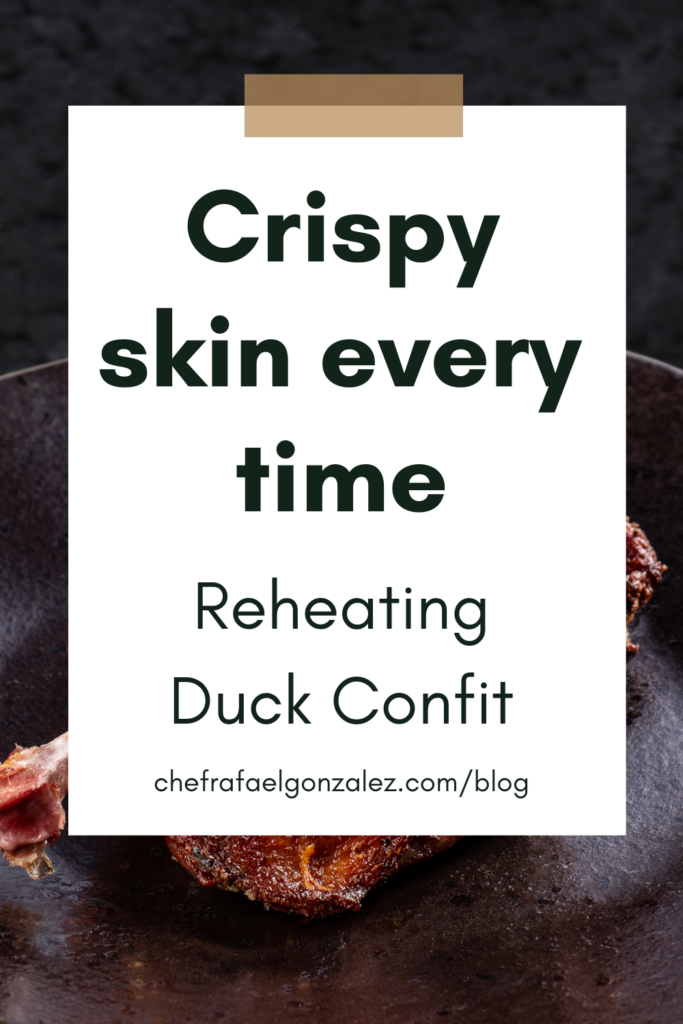
Understanding Duck Confit
Duck confit, a classic example of French culinary craftsmanship, leverages a time-honored preservation method. Traditionally, chefs would season duck legs with salt before slowly cooking them in rendered duck fat.
This age-old technique ensured that the rich meat remained tender and flavorful over time. Preserved in its own fat, duck confit showcased the ingenious ways people made food last before refrigeration. Today, it stands not just as a testament to culinary history but also as a dish distinguished by its rich flavors and succulent texture.
The technique, originating from the necessity of preserving duck in plenty of duck fat, has found modern appreciation. Even though we now enjoy it for taste rather than necessity, the method remains an homage to the brilliance of ancient kitchens. A home cook can easily use the same technique and achieve the same results of a traditional duck confit recipe.
Preparation Before Reheating
We always start by taking our duck leg confit (or the chicken legs and thighs confit) from the refrigerator. This allows it to reach room temperature, ensuring an even reheating process. Patience is a virtue here; rushing could mean uneven cooking later.
Next, we tackle the excess fat. Initially, it might seem counterintuitive to remove what adds so much flavor. However, eliminating some of this fat is crucial.
You need to carefully scrape off the excess, leaving just enough duck fat to coat the bottom of the roasting pan or baking dish later. This step guarantees the meat stays tender while the skin turns deliciously crispy. It’s a delicate balance, but one that will lead to the rich flavors and golden brown finish we are aiming for.
Following these initial preparations will see you up perfectly for the reheating methods we’ll describe later, each promising to restore the duck legs or chicken thighs to their former glory with that sought-after crispy skin, even if it’s on the next day.

Oven Reheating Method
We realized that reheating duck confit in an oven ensures not just warmth but revives its rich flavors perfectly.
Lay out the duck legs or the chicken thighs on a baking sheet tray, skin side up, ensuring they do not touch. This single layer guarantees heat wraps around every part evenly. Now, heat oven to a low temperature — never rush this process at high heat.
Wrapping the tray loosely with aluminum foil avoids drying out the meat while retaining that tender touch inside.
A crucial step involves removing the foil in the final moments of the cooking time. Increase the oven temp slightly to medium-low heat. This tactic is our little secret for achieving that golden brown, crispy skin that cracks beautifully at the first bite. For us, it’s the best way to bring duck confit back to life, almost like it was freshly prepared. This method is so versatile, we even apply it when reheating with a toaster oven for a quick meal. Remember, patience during reheating rewards you with the most flavorful duck (or chicken), as if you were eating it for the first time.
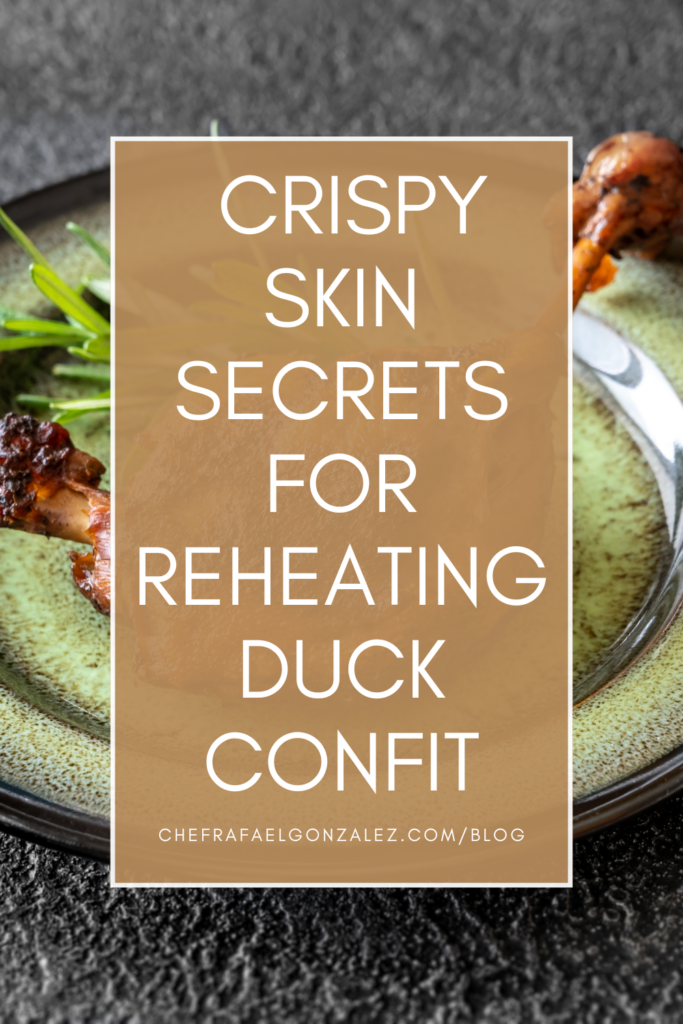
Top of the Stove Reheating Technique
Achieving crispy duck skin starts in a cast iron skillet, warmed over medium heat.
A splash of olive oil coats the bottom, preparing it for the next step. Lay the duck legs skin side down, ensuring they don’t crowd together. This single layer is so important for even reheating and achieving that golden brown finish. Patience will be your friend as the legs sizzle gently, their fat rendering slowly into precious liquid gold.
Occasionally you can pour off the excess hot duck fat, keeping the skillet clear and the focus on crisping the skin. After moving the duck or chicken around the medium-high heat, you can flip them. The underside now faces the heat, but the real magic has already happened. The skin, a crispy armor with rich flavors, invites us to savor the tender meat within.
When you reheat on the top of the stove, you’re leveraging the confit’s own fat. This technique elevates the duck legs or the chicken thighs to perfection.
Alternative: Sous Vide Reheating
There’s another incredibly rewarding method for reheating duck confit that maintains its tender meat while ensuring that delightful crispy skin.
This technique, known as sous vide reheating, involves a water bath at a low temperature. It’s a game changer. Sous vide ensures that the hearty duck meat warms evenly, preventing any chance of overcooking.
Those familiar with the sous vide techniques appreciate the precision it brings. By sealing the duck confit in a vacuum bag and submerging it in water gently warmed by a sous vide device, every piece comes out perfectly. We love how this method respects the rich flavors and delicate textures that are the hallmark of a well-prepared confit. Imagine, after a slow bath in the water oven, removing your confit duck legs to find them just as juicy as the day you first cooked them.
Then, a quick sear in a hot pan gives the skin that incomparable crunch. It’s as simple as that – culinary magic at its finest.

Serving Suggestions
Beyond duck, chicken thighs or legs make an excellent substitution.
They brim with flavor when served beside Moroccan-style couscous filled with vibrant vegetables. It turns out to be a light yet satisfying meal, ideal for those warm summer nights. We even shared this in a previous post. You can get the how to right HERE.
Ensuring the duck or chicken confit retains its tender meat while achieving a crispy skin is huge for us. It’s the only way to enjoy it.
Reheating this dish transforms it, making each serving feel like an entirely new experience rather than mere leftovers. The key lies in reheating gently to maintain the moist, rich flavors of the confit. Whether it catches a slow bake in the oven or a precise warm-up on the stove top, the outcome must give you that golden brown finishing touch. This method, we’ve found, offers a flavorful duck or chicken that pairs marvelously with the delicate spices and textures of a Moroccan couscous.
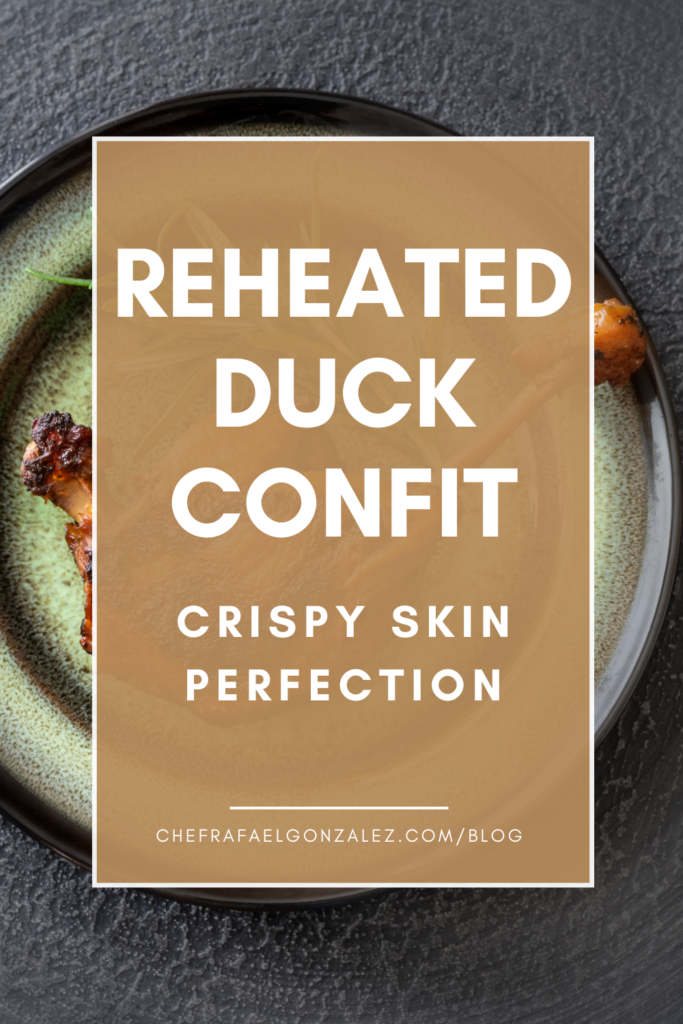
Storage Tips for Duck Confit
Ensuring your duck confit or chicken thighs confit remains delectable requires proper storage.
The best method involves submerging it completely in its own fat. This layer acts as a preservation coat, warding off air exposure that could spoil the tender meat. Store it in a cool place, ideally at the back of your refrigerator, where temperatures stay consistently low. For those passionate about traditional duck confit recipes, using a sealable plastic container or vacuum bag will prove especially effective in maintaining freshness.
Always keep an eye on the internal temperature if using a water oven or sous-vide techniques. These tools can help keep the duck confit safely stored at a low temperature. Whether stored in a nonstick skillet or a Dutch oven, ensure it’s tightly wrapped with aluminum foil or placed under a weight to maintain its shape and density. The fat keeps the rich flavors intact, allowing for future use in other decadent dishes.
Remember, reheating at a low temperature is crucial to retain that much-sought-after crispy skin.
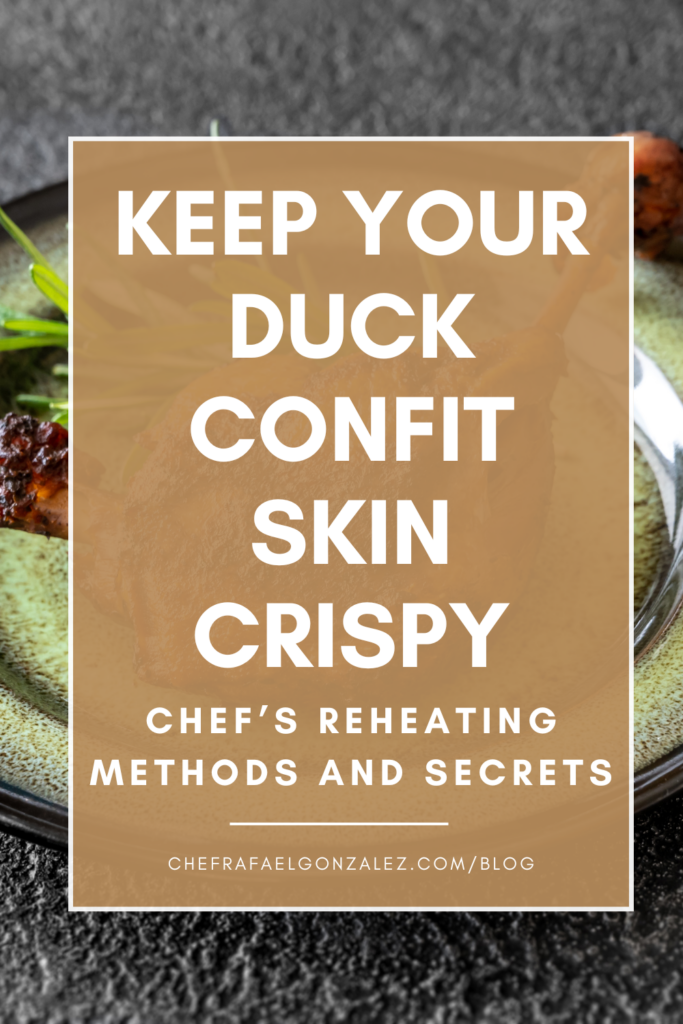
Common Mistakes to Avoid
Many home cooks eager to enjoy leftover duck confit fall into traps that compromise the dish’s delightful textures.
High temperature reheating turns supple duck meat into a tough disappointment. The rapid heat kills delicate flavors cultivated through the slow cooking process. Likewise, overcrowding the pan promises a similar fate. It steams rather than crisps, leaving the skin flabby instead of the aspired golden brown crunch.
Another pitfall is rushing without allowing the confit to reach room temperature first. Meat straight from the cold contracts when hit by heat, squeezing out moisture before the fat can render.
Rushing has no place in the art of reheating duck confit.
A low and slow approach in the oven ensures heat gently permeates, preserving tender meat within while coaxing the skin to a perfect crisp.
Equally important, avoiding the temptation to flip the pieces frequently on the stovetop keeps the skin intact for that quintessential crackle. I always tell my students, “FLIP ONLY ONCE”.
Patience and proper technique will guarantee every reheating session enhances rather than diminishes the duck confit’s rich flavors.

Personal Touch and Additional Resources
We’ve just walked through the steps of reheating duck confit (or chicken confit), aiming for that crispy skin.
But, the path doesn’t end here.
Experimentation is key. Not every oven behaves the same. Stovetops can differ.
Our recommendation? Test the waters with the oven, play with the medium-high heat of the stovetop, and don’t overlook the finesse that the sous vide method brings to the table. Each technique, from using a dutch oven to a simple nonstick skillet, adds its unique touch to the finished product.
If you’re looking for a full recipe, our blog has a full recipe that will teach you step by step (we used chicken thighs). We teach the confit method using olive oil, if you’re not using duck fat. You’ll discover the magic behind slow cooking processes, to perfecting the crispy finish with a hot pan on the stove top.
Let your kitchen be your playground. Whether it’s by following our tried and true recipes or crafting your unique blend of herbs and techniques, the goal remains the same – a delicious, flavorful dish that warms the soul. And remember, practice makes perfect. Reheating duck confit or chicken confit to achieve that deliciously crispy skin will feel like second nature.
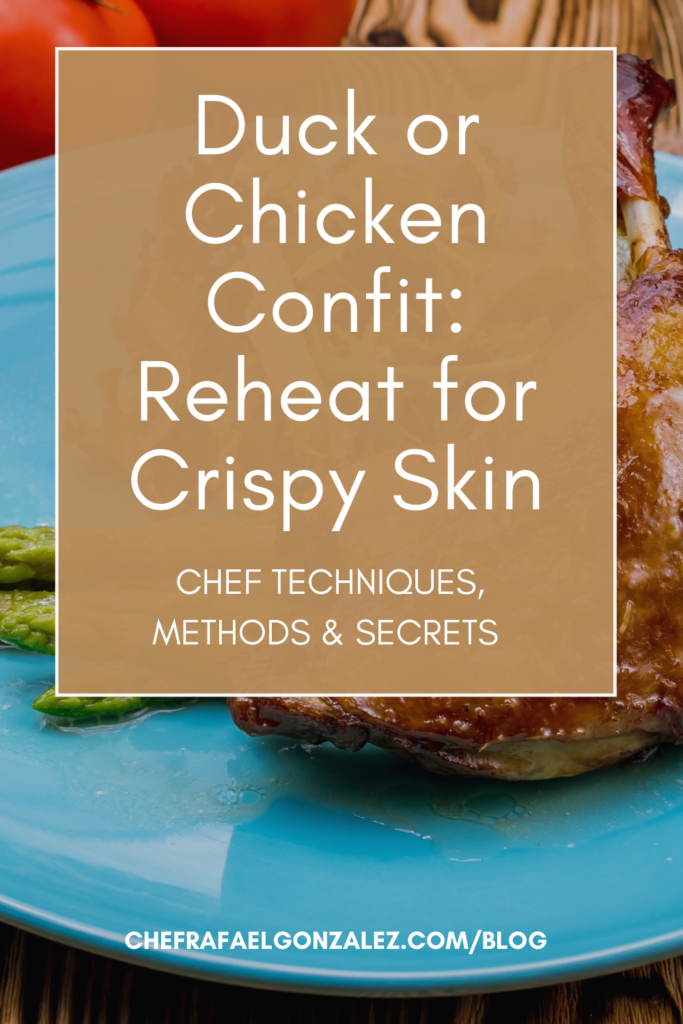
A Crispy Farewell
We have shared our secrets and turned every stone to help ensure your duck confit, or even that alternative chicken thighs confit, comes out crispy and rich in flavors every single time.
Remember, cooking duck legs or any confit lies not just in the method but in the patience and care with which you apply it.
It’s about embracing the slow cooking process, letting the duck’s own fat work its magic, and achieving that irresistible crispy skin that adds a delightful textural contrast to the rich meat.
We encourage you to not shy away from experimenting, be it with different types of poultry like chicken thighs and legs.
As you move forward, eager to test these techniques in your kitchen, be reminded that the adventure doesn’t end here. We’ve taken our experiences and laid them bare on our blog and through our YouTube channel. These resources are there to guide, inspire, and help you refine your cooking. So, read our blog and watch our video, so you can elevate your cooking and continue to be inspired throughout your home cooking journey.
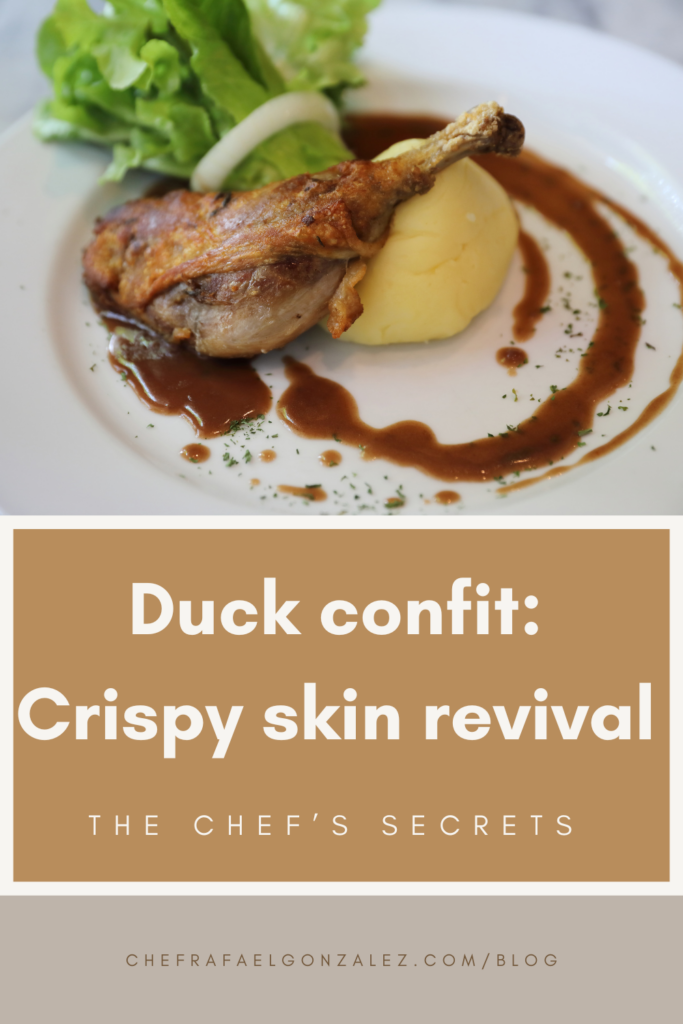
Be the first to comment